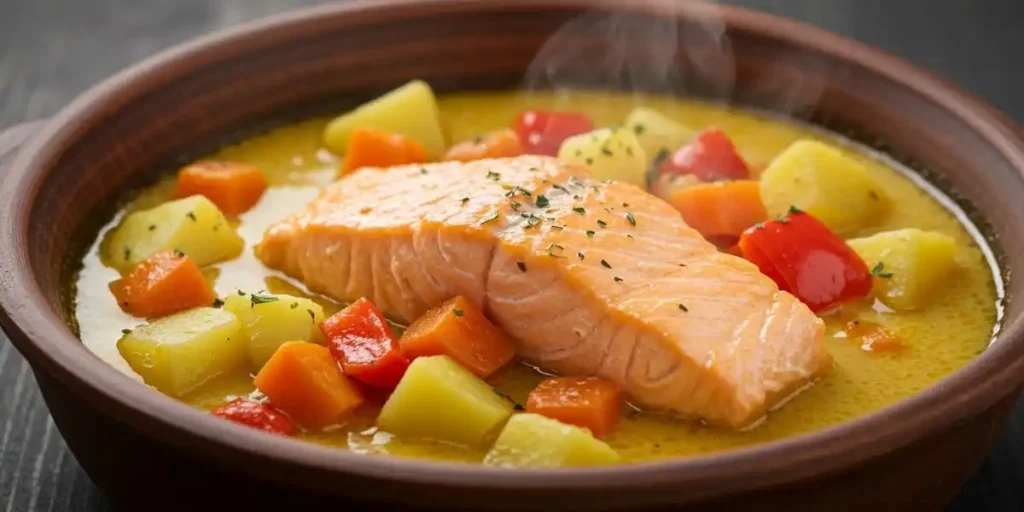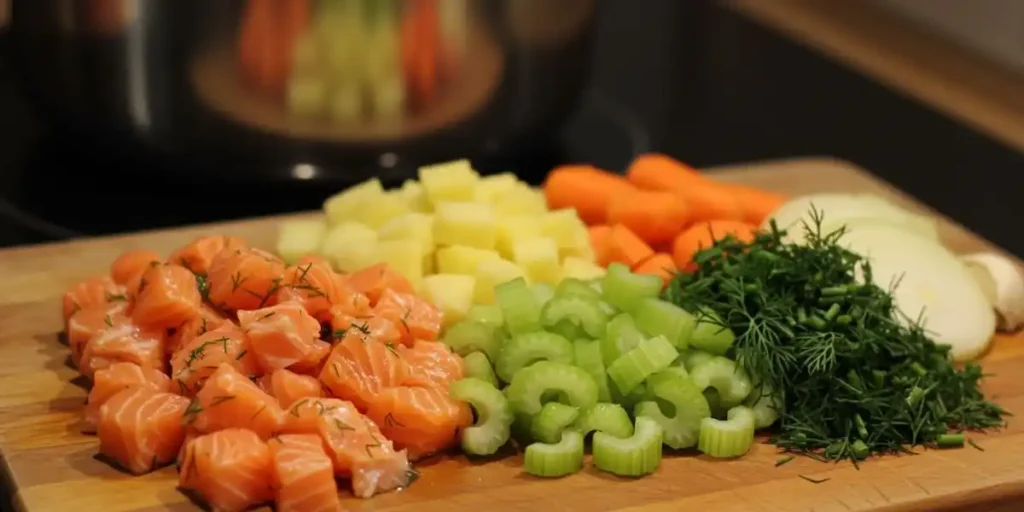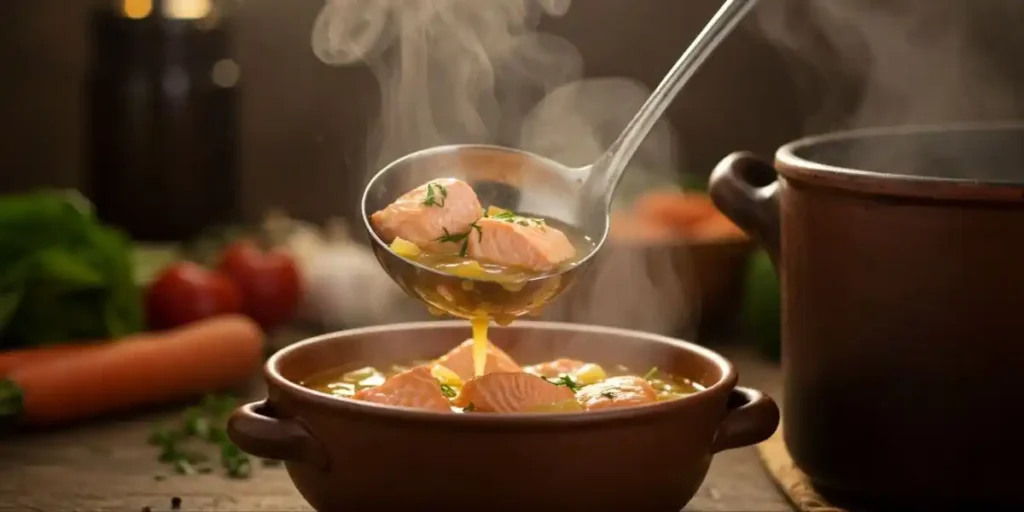There’s something truly special about a warm bowl of stew. It’s the kind of dish that conjures up cozy evenings, comforting aromas, and the feeling of being utterly nourished from the inside out. And while many stews require hours of simmering, this Quick Salmon Stew recipe is a delightful exception!
Imagine having a comforting meal ready in 30 minutes after a long day. With its creamy broth and tender salmon, this Salmon Stew is perfect for busy weeknights when you want something hearty and satisfying but don’t have hours to spend in the kitchen.
Forget complicated techniques and lengthy ingredient lists. I will walk you through a simple, step-by-step guide to creating this flavor-packed Salmon Stew. Get ready to enjoy a creamy, savory, and utterly satisfying dish that’s as good for you as it tastes.
Why You’ll Love This Quick & Easy Salmon Stew

Ready in Just 30 Minutes – Perfect for Busy Weeknights!
Life is busy! Finding time to cook a delicious and nutritious meal can feel impossible between work, family, and everything in between. That’s where this Salmon Stew shines. Forget slaving over the stove for hours; this recipe is designed to fit seamlessly into even the most hectic weeknight schedule. You’ll have dinner in just half an hour, from prepping the ingredients to serving a steaming bowl. No more takeout menus or processed meals – you can enjoy a homemade, wholesome meal without the time commitment!
Hearty and Healthy – Packed with Omega-3s & Vegetables
This isn’t just a quick meal; it’s a nutritional powerhouse! Salmon is packed with heart-healthy Omega-3 fatty acids, essential for brain function and overall well-being. Plus, it’s a fantastic source of lean protein, helping you feel full and satisfied. Vibrant vegetables like potatoes, carrots, and celery add valuable vitamins, minerals, and fiber. And if you’re dairy-free, no problem! Swap the heavy cream for coconut milk for a creamy, delicious stew that everyone can enjoy.
One-Pot Wonder – Minimal Cleanup
Who loves doing dishes? (Spoiler alert: probably no one!). The beauty of this Salmon Stew is that it’s an authentic one-pot meal. That means all the cooking happens in a single pot, from sautéing the vegetables to simmering the stew. Less fuss and mess, and more time to relax and enjoy your delicious meal! Cleanup is a breeze, leaving you more time to spend with family or unwind after a long day.
Flavorful and Creamy – Simple Ingredients, Big Taste
Imagine sinking your spoon into a bowl of creamy, savory goodness. The tender salmon flakes apart in your mouth, complemented by the sweetness of the carrots, the earthiness of the potatoes, and the subtle aroma of fresh dill. A touch of lemon juice brightens the flavors and adds a delightful zing. This isn’t a bland, boring stew; it’s a flavor explosion in every spoonful, achieved with minimal effort and readily available ingredients.
Budget-Friendly – Ingredients You Can Find Easily
You don’t need to be a gourmet chef or spend a fortune on exotic ingredients to create a restaurant-quality meal at home. This Salmon Stew recipe uses common, affordable ingredients that you can easily find at your local grocery store. We believe everyone deserves access to delicious and nutritious meals without breaking the bank, and this recipe delivers on that promise.
Ingredients You’ll Need for Your 30-Minute Salmon Stew

The Star: Fresh Salmon Fillets
The heart of this delicious stew is undoubtedly the salmon. For the best flavor and texture, opt for fresh salmon fillets. Sockeye salmon, known for its rich, robust flavor and vibrant red color, is an excellent choice. Coho salmon is another great option with its milder taste and slightly softer texture. When selecting your salmon, look for firm, vibrant flesh that springs back when lightly pressed. Steer clear of salmon that looks lifeless or smells too fishy. Salmon steaks are a perfectly acceptable alternative if you can’t find fillets. Remove the skin and bones before adding them to the stew.
The Broth: Vegetable or Fish Stock?
The broth forms the flavorful foundation of the stew. You have two main options: vegetable broth or fish stock. Vegetable broth offers a lighter, cleaner flavor, allowing the salmon’s taste to shine. On the other hand, fish stock provides a deeper, more intense seafood flavor, complementing the salmon beautifully. Consider your personal preference and the overall flavor profile you’re aiming for. You can also use bouillon cubes dissolved in water in a pinch, but be mindful of the sodium content. Opt for low-sodium bouillon if possible.
The Veggies: Potatoes, Carrots, and Celery
These humble vegetables are essential for adding heartiness, texture, and a touch of sweetness to the stew. Potatoes provide a creamy, comforting base, while carrots add a subtle sweetness and vibrant color. Celery contributes a fresh, aromatic note that balances the richness of the salmon and cream. With their buttery flavor and smooth texture, Yukon Gold potatoes work exceptionally well. Red potatoes, which hold their shape well during cooking, are another great choice. Don’t be afraid to try other vegetables too! Adding peas, corn, or even a handful of spinach can add extra nutrients and flavor.
The Cream: For Richness and Flavor
A touch of cream elevates this stew to a genuinely decadent level. Heavy cream adds a luxurious richness and velvety texture. If you’re looking for a dairy-free alternative, swap the heavy cream for one can of full-fat coconut milk. It provides a similar creaminess with a subtle hint of coconut flavor that pairs surprisingly well with salmon. For a tangier twist, stir in a dollop of sour cream just before serving.
Herbs & Seasoning
The right herbs and seasonings can transform a simple stew into a culinary masterpiece. With its bright, grassy aroma, Fresh dill is a classic pairing with salmon and adds a delightful freshness. If fresh dill isn’t available, dried dill can be used, but use about half the amount. A bay leaf adds a subtle depth of flavor that infuses the entire stew. Don’t forget the basics: onion and garlic for aromatic complexity, salt and pepper to enhance the flavors, and a squeeze of lemon juice (or a splash of white wine vinegar) to brighten the stew and add a touch of acidity.
How to Make Quick and Easy Salmon Stew: Step-by-Step Instructions
Preparation (5 Minutes):
Before you start cooking, a little prep work will streamline the process and ensure your stew is ready in 30 minutes. First, dice one medium onion, two carrots, and two celery stalks into bite-sized pieces, about ½-inch in size. Next, peel and dice one pound of potatoes (Yukon Gold or red potatoes work well) into similar-sized pieces. Cut about 1 pound of fresh salmon fillets into 1-inch cubes. Finally, mince two garlic cloves and chop approximately ¼ cup of fresh dill. Prepping your ingredients and ready to go will make cooking a breeze!
Sauté the Vegetables (5 Minutes):
Heat 2 tablespoons of olive oil (or butter, for added richness) in a large pot or Dutch oven over medium heat. Add the diced onion, carrots, celery, and sauté for about 5 minutes or until the vegetables soften. Stir occasionally to prevent burning. You want the vegetables to become slightly translucent and release their aromatic flavors. Once softened, add the minced garlic and cook for another minute, stirring constantly, until fragrant. Watch the garlic closely to avoid burning it; it might turn bitter.
Simmer the Stew (15 Minutes):
Pour in 4 cups of vegetable broth (or fish stock for a more intense seafood flavor). Add the diced potatoes, one bay leaf, ½ teaspoon of salt, and ¼ teaspoon of black pepper. Bring the mixture to a simmer over medium-high heat, then reduce the heat to low, cover the pot, and simmer for 15 minutes or until the potatoes are tender and easily pierced with a fork.
Add the Salmon and Cream (5 Minutes):
Gently stir in the cubed salmon pieces and ½ cup of heavy cream (or coconut milk for a dairy-free option). Be careful not to over-stir, as the salmon is delicate and can easily break apart. Simmer the stew for another 5 minutes or until the salmon is cooked. The salmon should be opaque and flaky when gently pressed with a fork. Avoid overcooking the salmon, as it can become dry and rubbery.
Finishing Touches:
Remove the bay leaf from the stew. Stir in the chopped fresh dill and one tablespoon of fresh lemon juice (or white wine vinegar). The lemon juice will brighten the flavors and add a touch of acidity. Sample the stew and tweak the flavors by adding more salt, pepper, or lemon juice to suit your taste.
Serving Instructions:
Ladle the hot salmon stew into bowls and serve immediately. Garnish with an extra sprinkle of fresh dill and a lemon wedge for an additional flavor. Crusty bread is a wonderful accompaniment for sopping up the delicious broth. Enjoy!
Tips and Variations for the Best Salmon Stew
Choosing the Best Salmon:
Selecting the right salmon is crucial for a truly outstanding stew. While any salmon will work, certain varieties offer distinct flavor profiles. Sockeye salmon boasts a rich, robust flavor and a firm texture, making it a classic choice. Coho salmon is known for its milder, more delicate flavor, perfect for those who prefer a less intense taste. King salmon (also known as Chinook) is the most prized variety, offering a buttery flavor and melt-in-your-mouth texture, but it’s also the most expensive. When choosing fresh salmon, look for flesh that is firm, vibrant in color, and has a fresh, sea-like smell. Avoid salmon that looks dull, feels mushy, or has a strong fishy odor.
Making it Dairy-Free (Coconut Milk Option):
Substitute the heavy cream with full-fat coconut milk for a delicious dairy-free version of this Salmon Stew. Coconut milk provides a similar creamy texture and richness, with a subtle hint of coconut flavor that complements the salmon. Be sure to use full-fat coconut milk, as the light version can be too watery and won’t provide the same level of creaminess. You might notice a slight difference in flavor compared to the traditional version, but the coconut milk adds a unique and delicious twist.
Adding More Vegetables:
Feel free to get creative and add your favorite vegetables to this Salmon Stew! A cup of frozen peas or corn adds a touch of sweetness and vibrant color. A handful of fresh spinach wilts beautifully into the stew, adding valuable nutrients. Sliced mushrooms provide an earthy flavor and meaty texture. Other great options include green beans, zucchini, or diced bell peppers. When adding extra vegetables, adjust the cooking time to ensure they are cooked through but not overcooked.
Spice it Up (Adding Some Heat!):
If you enjoy a bit of heat, add a pinch of red pepper flakes to the stew while it simmers. Start with a small pinch (about ¼ teaspoon) and add more to taste. A dash of your favorite hot sauce (Tabasco or Sriracha) can add a pleasant kick. Add minced jalapeño pepper, onion, and garlic for a more complex flavor.
Making it Ahead of Time:
This Salmon Stew is a great make-ahead meal! Let the stew cool entirely so the flavors can deepen, then store it in an airtight container in the fridge for up to 3 days. To reheat, gently warm the stew over low heat on the stovetop, stirring occasionally, until heated. Avoid boiling the stew, as this can cause the salmon to become dry and rubbery. You can also reheat it in the microwave, but stir it frequently to ensure even heating.
What to Serve with Salmon Stew:
The right side dishes can elevate your Salmon Stew to a satisfying meal. Golden, crusty bread is the best for soaking up every drop of flavorful broth. A simple side salad with a light vinaigrette provides a refreshing contrast to the richness of the stew. Garlic bread adds a touch of indulgence. Ladle the stew over warm rice or fluffy quinoa for a more filling meal.
Frequently Asked Questions (FAQ) About Salmon Stew
Can I use frozen salmon?
Answer: Absolutely! Frozen salmon is a convenient and perfectly acceptable option. However, it’s crucial to thaw it thoroughly before adding it to the stew. Place salmon in the fridge overnight for perfect results to safely thaw salmon. If you’re short on time, you can thaw it in a sealed bag in cold water, changing the water every 30 minutes until thawed. Ensure the salmon is completely melted before adding it to the stew for even cooking and optimal texture.
Can I use milk instead of cream?
Answer: You can certainly use milk instead of cream, but be aware that it will produce a less rich and creamy stew. Milk has a lower fat content than cream so that the texture will be thinner, and the overall flavor will be less decadent. If you choose to use milk, opt for whole milk for the best results.
How long does salmon stew last in the fridge?
Answer: Properly stored, cooked salmon stew lasts 3 to 4 days in the refrigerator. To maximize its shelf life, transfer the stew to an airtight container as soon as it has cooled completely. Be sure to refrigerate it within two hours of cooking to prevent bacterial growth.
Can I freeze salmon stew?
Answer: Yes, you can freeze salmon stew. However, upon thawing, the texture of the potatoes and cream may change slightly. The potatoes might turn somewhat lumpy, and the cream could break apart. Allow the stew to cool completely before transferring it to a freezer-safe container to minimize these changes. Leave some headspace in the container, as the stew will expand when frozen. Store in the freezer for 2-3 months to maintain optimal freshness. Thaw overnight in the refrigerator before reheating.
Is salmon stew healthy?
Answer: Absolutely! Salmon stew is a hearty and flavorful dish that nourishes the body and soul. Salmon is an excellent source of lean protein and heart-healthy omega-3 fatty acids essential for brain function and overall well-being. The addition of vegetables provides vitamins, minerals, and fiber. Salmon stew is a balanced and nourishing meal that can be part of a healthy diet.
What type of potatoes are best for Salmon Stew?
Answer: Yukon Gold and Red potatoes are generally considered the best choices for salmon stew. Both varieties hold their shape well during cooking, preventing them from becoming mushy. Yukon Gold potatoes have a buttery flavor and creamy texture, while Red potatoes have a slightly waxy texture and subtle sweetness. Other potato varieties, such as Russet potatoes, can be used, but they may break down more efficiently and result in a less appealing texture.

Looking for more healthy and delicious seafood recipes?
Check out our Healthy Seafood Dishes collection for more flavorful meals that nourish the body. If you need quick and easy dinner ideas, explore our Quick Weeknight Dinners to find more quick meals.
Do you love this Salmon Stew?
Share it with friends and family, and feel free to leave a comment below about how it turned out for you! You can also explore more of our hearty stews and soups for cozy, satisfying meals.

